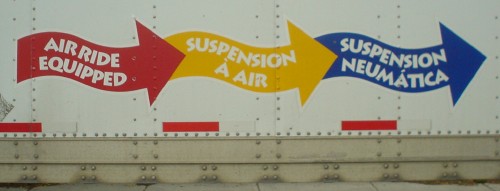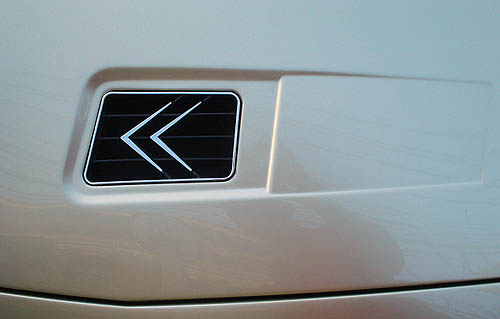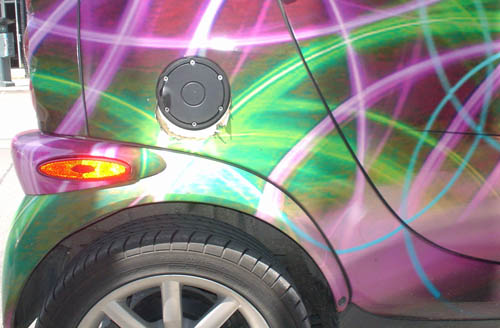I was not aware that Spanish was intrinsically blue.

French as intrinsically yellow I can get behind, though.
I was not aware that Spanish was intrinsically blue.

French as intrinsically yellow I can get behind, though.
The foregoing posting appeared on Joe Clark’s personal Weblog on 2006.06.20 15:45. This presentation was designed for printing and omits components that make sense only onscreen. The permanent link is: https://blog.fawny.org/2006/06/20/airride/
I suppose this is unremarkable on beaches in general. It is nonetheless a rather alien sighting one city block away from a major thoroughfare.

The foregoing posting appeared on Joe Clark’s personal Weblog on 2006.06.19 17:28. This presentation was designed for printing and omits components that make sense only onscreen. The permanent link is: https://blog.fawny.org/2006/06/19/leveller/
Oversharpening the photo gives the illusion that the ill-cut Cooper Black is raised out of the sign bed more than it is.

While this visual effect falsifies reality, I prefer it nonetheless.
The foregoing posting appeared on Joe Clark’s personal Weblog on 2006.06.17 15:52. This presentation was designed for printing and omits components that make sense only onscreen. The permanent link is: https://blog.fawny.org/2006/06/17/cooperbarber/
Uncial, Frutiger (apparently), and tacked-on Helvetica all in one sign.
If you’re going to go uncial, why not go uncial all the way?
The foregoing posting appeared on Joe Clark’s personal Weblog on 2006.06.16 16:01. This presentation was designed for printing and omits components that make sense only onscreen. The permanent link is: https://blog.fawny.org/2006/06/16/uncifrutvetica/
Recently, the ADInternational mailing list griped that I used the phrase “bullshit cold war” in an E-mail. I don’t know why they were acting offended, and of course it is an act. I swear, and, unless they’re full-on Mormons, so do they.
Nonetheless, I thought I’d take the opportunity to issue a reminder of what there really is to complain about in the field of audio descripion.
The foregoing posting appeared on Joe Clark’s personal Weblog on 2006.06.16 15:54. This presentation was designed for printing and omits components that make sense only onscreen. The permanent link is: https://blog.fawny.org/2006/06/16/dx-problems/

The foregoing posting appeared on Joe Clark’s personal Weblog on 2006.06.13 16:23. This presentation was designed for printing and omits components that make sense only onscreen. The permanent link is: https://blog.fawny.org/2006/06/13/chevrons/
I am quoted in an article in the 2006.06.05 issue of Canadian Communications Reports, one of those expensive industry newsletters (full title: Decima‘s Canadian Communications Reports, with opening single quotation mark instead of apostrophe). The topic is a private member’s bill stating, bluntly, “Each broadcasting undertaking shall broadcast its video programming with closed captions.”
That means closed captions, not open captions. And it means closed captions on everything, even programming that cannot be captioned (because it’s in a language that uses a non-Latin script that cannot be romanized, like Chinese), even silent movies, even sign-language programming. Obviously this ain’t gonna work.
Plus the bill proposes tax breaks to pay for captioning. I was under the impression that accessibility was a legal requirement and not something we deign to include if a government passes a law saying we can tax-deduct it.
Anyway, some relevant quotes from the article (“Closed-captioning bill flawed, accessibility advocates say”):
But Joe Clark, a Toronto-based accessibility consultant, says St. Hilaire’s proposal falls short of the mark in ensuring equal access for all with disabilities. “I’m really tired of everyone putting deaf people’s needs first. Deaf people are not more important than blind people, neither is more important than the other, and neither is more important than nondisabled people,” he says…. Clark points out that anything short of total equal access for the hearing-and visually impaired contravenes Section 15 of the Constitution Act (1982), which guarantees equal consideration under the law for all. At the current 90% quota, he adds, broadcasters could get away with airing more than a month of inaccessible programming every year. “Ten percent of that [year] is 36½ days. So if you wanted to, you could spend the whole month of December with no captioning”….
Clark says he’s documented numerous instances where the CBC has failed to live up to their commitments to total captioning…. [N]ot only does the CBC occasionally broadcast such content without captions, it also broadcasts subtitled programming without captions as well, perhaps believing that subtitles and captioning are synonymous…. “Section 15 of the Constitution [and] all the established human rights law for decades says it is a responsibility to provide accessibility. It is not an optional feel-good thing.”
The foregoing posting appeared on Joe Clark’s personal Weblog on 2006.06.13 16:19. This presentation was designed for printing and omits components that make sense only onscreen. The permanent link is: https://blog.fawny.org/2006/06/13/decima-quote/
Just don’t park ’er nose to curb.

The foregoing posting appeared on Joe Clark’s personal Weblog on 2006.06.10 13:55. This presentation was designed for printing and omits components that make sense only onscreen. The permanent link is: https://blog.fawny.org/2006/06/10/smart-en-ciel/
My esteemed colleague and I were driving along King (for we drive and, yes, are as shatterers of worlds) and I found myself blurting out loud “Why is there a Citroën SM and why is there a Citroën DS?” In fact, there were seven Citroëns all in one place, including 2CVs and some late-model variety uncomfortably resembling a Lada Samara.

My eyes widened and I giggled and clapped my flat-outstretched hands like a schoolgirl. I made us stop the car. I took pictures until I ran out of juice. I talked to the SM owner. (“Whenever you show people a Citroën SM, they think The Longest Yard: ‘Don’t you take my Maserati!’ Except it isn’t a Maserati. It’s a Citroën; the engine is a Maserati.”) I watched various Eurotrash in too-tight and/or ruffled shirts and overlarge shades clutch their twee twine-handled shopping bags as they regarded these alien creatures.
Our philosophical question de la journée: If we know these things hike themselves up to drive away on their hydraulic suspensions, why do they have to hunch back down again once parked? The French showing off or something?
The foregoing posting appeared on Joe Clark’s personal Weblog on 2006.06.09 11:57. This presentation was designed for printing and omits components that make sense only onscreen. The permanent link is: https://blog.fawny.org/2006/06/09/citroen/